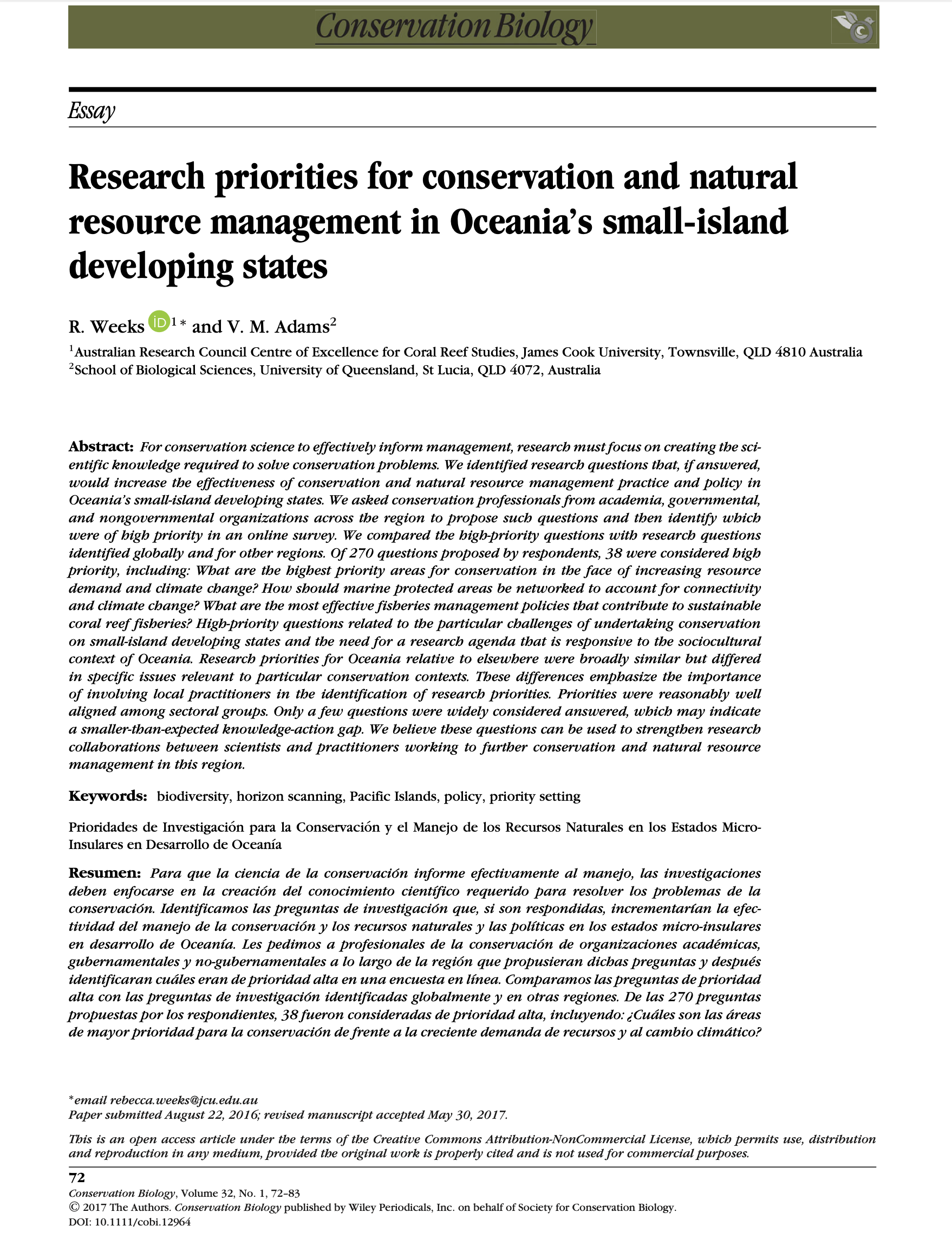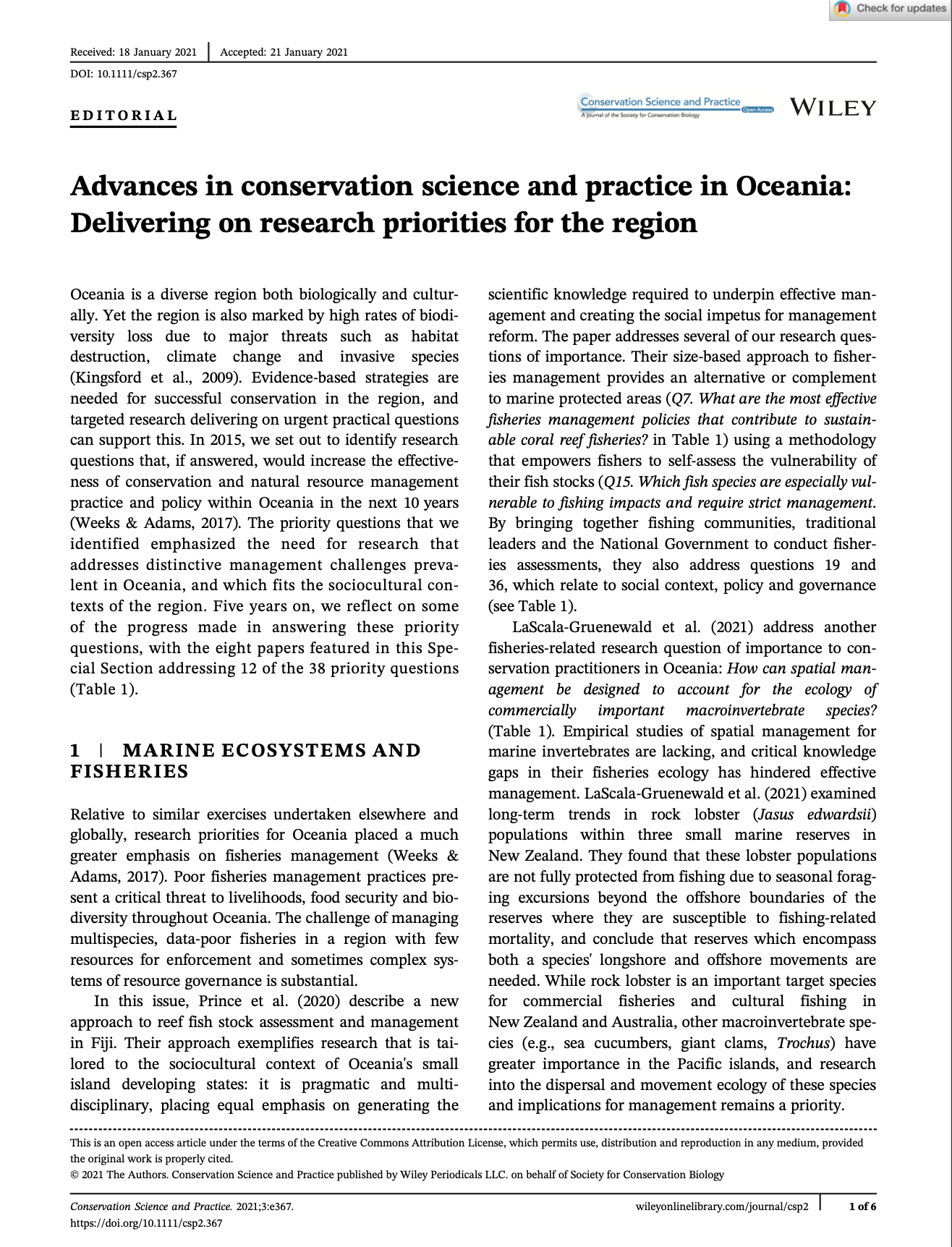In 2015, we set out to identify research questions that, if answered, would increase the effectiveness of conservation and natural resource management practice and policy within Oceania in the next 10 years (Weeks & Adams, 2017). Following a survey of conservation professionals from academia, governmental and nongovernmental organizations throughout the region, we identified 38 high priority research questions. These questions address both conservation theory and practice, and transcend biogeographic realms, the ecological and social sciences. The questions emphasised the need for research that addresses distinctive management challenges prevalent in Oceania, and which fits the sociocultural contexts of our region.
Five years on, we highlight some of the progress made in answering these priority questions, with a Special Section of Conservation Science and Practice. The eight papers in this Special Section address 12 of the 38 priority questions. However, we are aware of research published elsewhere which has tackled other questions, and there is undoubtedly further relevant research (published and forthcoming) and practice ongoing in Oceania of which we are unaware.
In an effort to support a research agenda that is responsive to practitioners’ information needs, we aim to document research that answers or addresses priority questions for conservation and natural resource management in Oceania here. We invite all conservation scientists and practitioners to contribute to this living repository of research which we hope will support evidence-based conservation action in Oceania and elsewhere.
The table below includes the 38 high-priority research questions identified by Weeks and Adams 2017, along with papers which address each question and their relevant findings.
If you are aware of other relevant research, please complete the submission form.
| Theme | Question | Paper | Relevant findings |
|---|---|---|---|
| Ecosystem management and restoration | Q1. What are the highest priority areas for conservation (and sustainable development efforts) in the face of increasing resource demand and climate change? | Adams et al. 2021 | |
| Q54. How can surveillance be better targeted to mitigate the risk of movement of invasive species? | Baker & Bode, 2020 | Occupancy modelling can be used to assess eradication success and optimisation the best allocation of resources between quarantine and surveillance, dependent on local context. | |
| Emery et al. 2021 | Better surveillance and control of the invasive wolf snake on Christmas Island may have averted the decline and extinction of native reptiles. | ||
| Protected areas | Q2. How should marine protected areas be networked to account for connectivity and climate change? | Adams et al. 2021 | focuses on terrestrial aspects and cross realm connectivity for marine areas. |
| Q16. What is the true cost of implementing effective protected areas in Oceania, and who will pay that cost? | |||
| Fisheries | Q3. What minimum level of protection is needed to ensure the long-term sustainability of coastal fisheries stocks under future projected changes to coastal habitats and species? | ||
| Q7. What are the most effective fisheries management policies that contribute to sustainable coral reef fisheries? | Prince et al. 2020 | describe a size-based approach to fisheries management which provides an alternative or complement to marine protected areas | |
| Q15. Which fish species are especially vulnerable to fishing impacts and require strict management? | Prince et al. 2020 | demonstrate how fishers can self-assess the vulnerability of their fish stocks. | |
| LaScala-Gruenewald et al. 2021 | found that species which undertake seasonal foraging excursions may be afforded less protection by marine reserves and thus be more susceptible to fishing-related mortality. | ||
| Q20. What are the key economic, policy, and management changes that need to be implemented to better sustain tuna stocks in the region? | |||
| Q23. How can we measure total fisheries catch of Pacific Islands, given that fish landings are often dispersed and unreported? | |||
| Q24. Which fisheries need to be protected most for future generations after coral reefs collapse from climate change and ocean acidification | |||
| Q33. How should periodically harvested closures be designed and managed to maximize their ability to conserve fish stocks and provide for short term needs? | |||
| Marine Ecosystems | Q4. How can spatial management be designed to account for the ecology of commercially important macroinvertebrate species (e.g. sea cucumbers, giant clams, Trochus, etc.)? | LaScala-Gruenewald et al. 2021 | Work on rock lobsters in New Zealand shows that reserves which encompass both a species’ longshore and offshore movements are needed to provide full protection. |
| Q11. Where are areas of critical importance (breeding, feeding) to oceanic, pelagic and migratory species within Pacific Island nations, and are there areas of overlap for multiple species? | |||
| Q22. Which characteristics of oceanic coral reefs confer resilience to natural and human disturbances? | |||
| Q47. How do larval dispersal patterns vary among species and how spatially or temporally consistent are these patterns for a given species? | |||
| Impacts of conservation interventions | Q5. What is the comparative feasibility and cost-effectiveness of different land- and marine-based conservation actions to mitigate key threats to coastal-marine ecosystems? | Adams et al. 2021 | |
| Q12. What conservation strategies are most successful in engaging isolated communities in the Pacific? | |||
| Q27. What conservation intervention has the largest impact on restoring native species and indigenous cultures? | Kingsford et al. 2020 | Invasive species control, predator-proof fencing, native herbivore management, and waterpoints removal are being used in Sturt National Park, Australia to restore ecosystem health and reintroduce locally extinct mammals. | |
| Irwin et al. 2021 | Fenced sanctuaries are effective at conserving kākāriki, with a dispersal study showing that many animals that left the sanctuary succumbed to predation. | ||
| Climate change | Q6. How will the anticipated loss of biodiversity associated with climate change, sea level rise and ocean acidification impact local economies and human health throughout the Pacific? | ||
| Q14. How can protected areas be designed to address impacts of future climate change? | Adams et al. 2021 | ||
| Q43. How do we build long term climate change planning into an environment focused on short-term disaster risk reduction? | |||
| Q67. How will ongoing climate change impact the ability of coral reefs to recover from routine disturbances (e.g., cyclones) or anthropogenic disturbances (e.g., overfishing)? | |||
| Terrestrial & freshwater ecosystems | Q8. What are the minimum areas needed to sustain populations of terrestrial island species? | ||
| Q18. How can we manage water resources to preserve and yet utilize? | |||
| Policy and governance | Q9. How do we move from a donor dependent conservation ethic to a self-sustaining approach to incentivizing or funding protected areas? | ||
| Q36. How can scientific information be communicated effectively to Pacific Island politicians to influence decision-making? | Prince et al. 2020 | present a theory of change wherein data and information gathered by community science programs motivates policy development at the national level | |
| Q44. How do we align policies, laws, rules, and regulations across levels of government to have a holistic approach to conservation and management of natural resources? | |||
| Species management | Q10. How can invasive species be most effectively controlled with the few resources available? | Butt et al. 2020 | Surveillance and control of new arrivals were recommended management approaches for weeds on Pilbara islands. Removal of propagule source populations was not deemed cost-effective. |
| Baker & Bode, 2020 | Prioritisation, return-on-investment, value-of-information, multi-objective decision analysis, and other quantitative tools can assist in island eradications. | ||
| Q41. What are the specific local- and landscape-scale habitat requirements of Pacific at-risk endemics? | |||
| Q64. Can we develop novel molecular or genetic approaches to small mammal pest control (including lethal viruses) that will be socially acceptable? | |||
| Societal context and change | Q13. What incentives can be provided to local resource owners to contribute towards national conservation and management of natural resources? | ||
| Q19. How can governments work effectively with communities to help them take ownership of managing their own resources in a more sustainable way? | Prince et al. 2020 | provide a case study of an approach to fisheries assessment which motivated collaboration between Fijian fishing communities, traditional leaders, and the National Government. | |
| Ecosystem function & services | Q30. How much habitat loss, fragmentation, and degradation is occurring on Pacific islands and what impact is it having on native wildlife? | ||
| Q39. What are the stress points at which ecosystems flip from a desirable state to an undesirable one and how can this be avoided? | |||
| Q34. How can we combine the best modern science with the best indigenous and local knowledge as a basis for biodiversity conservation and sustainable use in Oceania? | |||
| Q17. How can conservation oriented natural resource management interventions contribute to livelihood improvement in the Pacific Islands? | |||
| Q28. What alternative livelihoods from fishing can sustainably provide economic gains and food security to island communities? | |||
| Q49. How can we determine ecological carrying capacity for tourism in small island developing states? |


